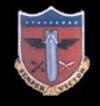Schwoegler
re-opened the hatch door and jumped. He did not know how high
he was, and he had never taken a parachute dive in his life.
The pilot, after aiming the plane away from the crew, was the
last to jump. Schwoegler successfully deployed his parachute
and was still in the air when the saw the plane explode against
the surface of the Pacific Ocean.
"Even
with a parachute you hit that water hard," Schwoegler recalled.
"Half the Pacific Ocean went up my nose." Schwoegler managed
to swim to the surface where he attempted to inflate a lifeboat
that was part of his gear.
"I
pulled it open and nothing
," he said. Fortunately he was able
to manipulate the CO2 cartridge that inflated his raft and get
it to work. The plane's crew was spread over a broad area, but
thanks to Schwoegler's signal a B-17 rescue plane was able to
locate the crew and drop them a Higgins lifeboat with food and
medical supplies.
Of
the 11 men in the crew, 10 were found. The flight engineer,
Schwoegler's best friend on the crew, did not know how to swim.
The co-pilot had taken him on his back when he jumped from the
stricken plane, hoping to assist the engineer when they hit
the water, but the force of the air tore the engineer from the
pilot's back and they fell separately.
"We
didn't talk about it afterwards," Schwoegler said. "We just
didn't. I don't know why."
Safe
in the lifeboat, the ordeal of the 10 survivors was not over.
"The
morning brought so much fog, you couldn't see from here to the
next house," Schwoegler explained. This hampered rescue efforts
and forced the crew to use a "Gibson Girl," a shapely radio
designed to be held between the legs and operated with a crank.
When cranked, the radio sent out a constant S.O.S. To send the
signal, an antenna was raised on a kite. As the radioman, the
job of cranking fell to Schwoegler.
"I
don't know how long I cranked," he said. "I was real disappointed
no one volunteered to take it except the navigator." His efforts
bore fruit in the form of a submarine.
"Is
it Japanese or American?" Schwoegler wondered. "Then I saw a
guy with a flaming red beard and I knew it was an American.
It was the best sight I ever saw."
Schwoegler
and the crew spent the next three or four days aboard the sub
before transferring to another sub that would take them back
to Guam. He still has the kite antenna that led the rescuers
to them, but he accidentally left the "Gibson Girl" on the first
sub when they transferred.
"The
(sub crew) loved having us," Schwoegler recalled. "They gave
up their bunks and everything. The first night (aboard) we ate
chicken and steak. We hadn't eaten like that in a while."
After
the return to Guam, the crew enjoyed a 10-day furlough in Hawaii
before getting back to duty in the Pacific, but the new plane
they were assigned had a dubious history. Under the control
of a different crew, the plane had reportedly done two loops
after entering a thermal over Tokyo. Some believed B-29s were
not capable of performing a loop, but this one did and Schwoegler
believed it emerged worse for wear. The plane was plagued by
mechanical problems including engine and cabin fires.
"We
weren't real happy about flying anymore," Schwoegler said.
Fortunately
the war would soon end. Schwoegler and his crewmates were among
those who flew over the battleship Missouri when the surrender
treaty was signed just in case the Japanese attempted anything
treacherous, "but we didn't have a bomb or bullet on board."
Schwoegler
also was able to see the damage caused by the war from the air.
"Tokyo
looked like a bunch of garden plots," he said.
As
for the second, rattletrap B-29, there is more to the story.
Shortly after the war ended the pilot from Schwoegler's crew
went home on personal business, and another crew took the plane
on a search mission. They never returned. Schwoegler thinks
he was lucky it wasn't him.
"We
would have been flying that plane," he said. "A lot of people
complain about dropping the H-bomb, but I wouldn't have been
here today. I have all confidence in that."
With
the war over, Schwoegler had accumulated enough points to come
home. Not terribly confidant in other crews and other planes,
he took a boat. He returned to Wisconsin, and in the fall of
1946 he re-enrolled at the UW where he would receive his degree
in agriculture. He parlayed his degree into a 30-year career
with the U.S. Department of Agriculture, working at many locations
throughout Wisconsin.
On
Sept. 4, 1948, he married Shirley, a Madison girl, and together
they raised seven children. The couple moved to Verona in 1972.
Following his retirement from the USDA, Schwoegler worked for
10 years at Four Winds Manor in Verona. He was in charge of
laundry, housekeeping, and maintenance.
This
story will come as a surprise to many people, even some who
have known Schwoegler for a long time. Until now, he has kept
much of his war story to himself.
"As
a group, the vets just didn't talk about it much," he said.
But now he thinks the time is right.
For
his service Schwoegler received the Air
Medal with two Oak Leaf Clusters,
the Purple Heart,
the Distinguished Flying
Cross, the Pacific Theater
Ribbon and the Good Conduct
Medal.
James E. Schwoegler took his Final Flight 19 May 2010.
A Mass of Christian Burial was held May 22 at 11am.
Burial was at Resurrection Catholic Cemetery.
|





